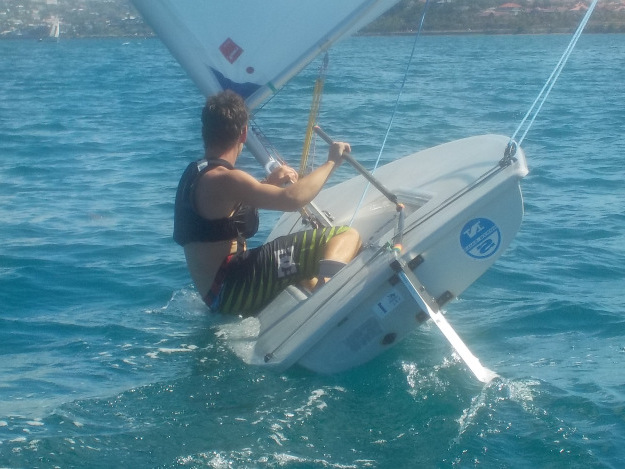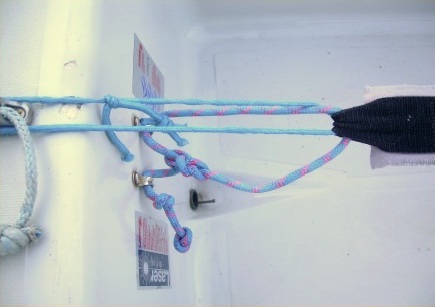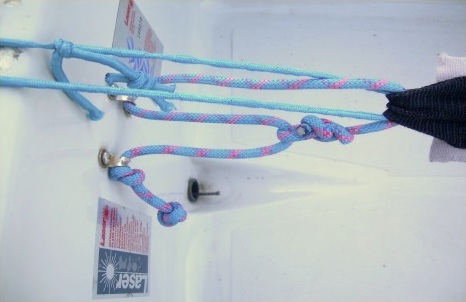Listening #
Explained to a beginner trainee...
The sheet is used to adjust the angle of the sail in relation to the wind, it is the one that ensures the propulsion of the sailboat. It is used to propel the sailboat. It is trimmed upwind and trimmed downwind.
- To trim upwind:
we observe the sail’s flutter, as soon as it appears, we trim a little to erase it. To be sure not to be over-trimmed, we regularly ease the sail to make the tacks appear, then we erase them.
- To trim downwind:
Place the sail at right angles to the wind.
Let’s release all the trimmers except the crow’s foot trim, which will stay tight, and the outhaul trim, which will be moderately taken, and place the boom perpendicular to the boat.
The sheeting action has two distinct effects:
- It closes the sail-boat angle, moving the boom in a horizontal plane (effect 1).
- When the boom is almost at the transom angle and we continue to trim, the sheet exerts a vertical tension bringing the boom block in contact with the bridle block. This tension is reflected in the leech of the sail, between the clew and the head, causing the mast to bend. (effect 2)

Adjusting the sheet

Mainline adjustment

Mainline Setting
This mast hanger resorbs the luff circle and flattens the sail. The tension exerted between the masthead and the clew of the sail “closes the leech”, i.e. prevents it from twisting.
The vang #
Explained to a beginner trainee...
The downhaul is used to conserve power between 2 upwind gybes and to manage overpower;
- To trim upwind:
It is used as soon as it is slack.
- To trim downwind:
It is tightened enough to prevent the boom from coming up more than at right angles to the mast.
Its action is close to the effect 2 of the sheet. By bringing its 2 insertions together (the front 1/4 of the boom and the part of the mast close to the stern), it exerts :
- a vertical tension which makes the leech “close” and bend the mast and the boom. This causes the sail to flatten and reduce its twist.
- compression of the boom on the mast, which can facilitate the bending of the mast in its lower part.
- it allows to keep a given profile of the sail when varying the sail-ship angle by action on the sheet, this is an essential condition for the efficient regulation of the overpower.

The action of the boom vang

The action of the halebas view_arriere

The laser downwind

The action of the halebas downwind
Le cunningham #
Explained to a beginner trainee...
We take the cunningham to erase the horizontal folds on the sail.
It exerts a vertical tension on the luff of the sail.
Its first interest is therefore to be able to correct the lower luff tension in relation to the leech. A good indicator is the characteristic presence of crow’s feet folds in the sail. In order to remedy these imperfect folds, the cunningham should be reworked until they are eliminated.

No action on the cunningham

Action on the cunningham
But this is not the only interest of the cunningham. Its essential functions are :
To bend the mast in addition to the vang or the sheet:
- When the mast is bent, the vertical tension due to the adjustment of the cunningham is slightly shifted towards the back of the mast.
- This tension, by “bow effect”, amplifies the mast bend and relieves the tension due to the downhaul or the sheet.
Move the sail’s hollow forward:
- When the wind strengthens, the hollow tends to move backwards, the cunningham allows, by bringing fabric forward, to recenter the hollow.
Relax the leech by over-tensioning the luff:
- This allows the upper part of the sail to “fade” into the wind, thus reducing the aerodynamic force. This twist is to some extent a self-regulation of the oversails by the rig.
La bordure #
Explained to a beginner trainee...
La bordure permet de doser la puissance.
On la choque jusqu’à 20 cm de creux dans la voile et on la reprend dès que l’on peine à maintenir le bateau à plat.
Le réglage de bordure permet de doser le creux général que l’on donne à la voile et donc la puissance de celle-ci. Il existe toutefois une limite au-delà de laquelle détendre la bordure cesse d’augmenter la puissance et transforme la voile en “sac”, perturbant ainsi les écoulements de l’air autour du profil.
Cette limite peut s’objectiver en mesurant la distance maximale séparant la bôme de la voile sur une perpendiculaire aux deux. De nombreux laseristes considèrent qu’elle est atteinte lorsque le pouce et l’auriculaire, écartés au maximum, joignent ces deux points (soit environ 20 cm).

Réglage de la bordure
La patte d’oie #
Explained to a beginner trainee...
One takes again the crow’s foot until the contact of the bar.
In association with the vang, it compensates for the absence of a clew carriage by keeping the boom off-center upwind.
To perform this role effectively, it is important that the bridle is strongly tensioned. Otherwise, the boom will rise and retract towards the center of the boat, so when the bridle adjustment is slackened, the block guided by it will be raised. The vertical tension exerted by the outhaul, by bringing this block closer to the one attached to the rear end of the boom, is then reduced. However, too much tension reduces the sensitivity of the tiller and hinders the passage of the block when tacking, especially in light airs. Therefore, it is a good idea to slightly relax the bridle if these symptoms appear and disturb the boat’s handling. The use of a Kevlar rope allows to obtain the same effect (off-center and low boom) with a lower tension.

Loose crow’s feet

Crow’s feet tighten
To adjust the crow’s foot, it is tightened to the maximum and if it hinders the passage of the pulley, it is slightly eased until the problem disappears.
La dérive #
Explained to a beginner trainee...
The daggerboard allows the sailboat to move forward as straight as possible by generating a force opposite to the force of the wind.
For upwind steering:
It is lowered to the maximum.
To trim on the beam:
It is raised 10 cm.
To adjust downwind:
It is raised 20 cm.

Daggerboard adjustement
The laser has a relatively flat hull and small appendages. Its anti-drift plane is therefore not very important in relation to its length.
- It is useful to place an adhesive tape to memorize the height of the daggerboard.
- It is very useful to place a handle on the daggerboard allowing it to be raised easily with one hand.
The two most common defects observed in trainees:
- Raising the daggerboard too much on downwind points of sail, when gybing, the boom comes to rest on the upper part and, if there is a wind, it is the desalination.
- Not lowering the daggerboard all the way in! You must use all the anti-drift surface possible, don’t deprive yourself of 2 centimeters.
La sangle de rappel #
Explained to a beginner trainee...
It is tighten up to the maximum to get the most versatile setting.
Many laserists opt for an adjustable abseiling strap. This adjustment is very important because it allows you to modulate the necessary comfort-torque compromise according to the speed and the wind and sea conditions encountered.
We present the most common setup:

Adjustment of the abseiling strap

Adjustment of the tighten abseiling strap
The tighter the strap, the lower the recall, but the easier the return to the boat.

Recall position
A useful adjustment marker is the distance of the scroll from the knee joint.
In gusty winds, it can be useful to tighten the abseiling strap in order to gain versatility: it will be easier to abseil out and in
